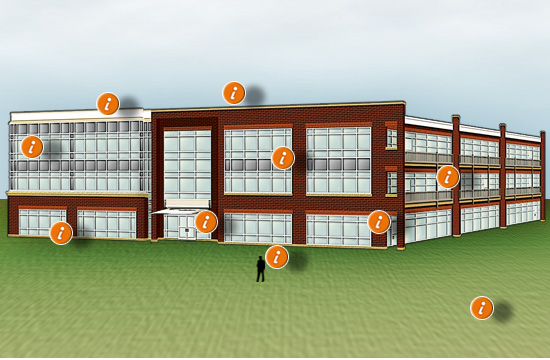Credit 5: Indoor Chemical &
Pollutant Source Control
The main entry includes a vestibule and two sets of doors to create a pressure differential that keeps potentially hazardous pollutants out of commonly occupied spaces. Entryway includes floor mats designed to capture potentially hazardous particulates and other pollutants.
Credit 1.2: Innovation in Design,
Increase Open Space More Than 50%
The building and parking area take up less than 50% of the site area leaving the remainder as open space. Much of the open space has been planted with native and adapted vegetation.
Credit 8.1: Daylight & Views,
Daylight 75% of Spaces
Building has been designed to bring daylight into 75% of regularly occupied spaces. Low-emissivity glass is used to reduce solar heat gain and heat loss.
Credit 7.2: Heat Island Effect,
Roof
The white roof reduces the temperature of the roof, thereby helping to lower the ambient air temperature.
Credit 5.1: Regional Materials,
10% Processed & Manufactured Regionally
Building materials extracted and manufactured regionally constituted 10% of the total materials value. Recycled steel came from Indiana, brick from Iowa, and glass from Ohio.
Credit 4.2: Recycled Content,
20% (post-consumer + 1/2 pre-consumer)
The materials for the project include approximately 20% recycled content. Some of the materials with recycled content include asphalt, steel, drywall, ceiling tile, insulation, aluminum curtain wall, the raised floor, carpet, hardware, concrete, case work and toilet partitions.
Credit 1: Optimized Energy
Performance
The building has been designed for improved energy performance relative to ASHRAE/IESNA Standard 90.1-2004. Features include a more efficient building envelope, through insulated low-emissivity glazing, increased insulation, and shading devices; efficient lighting with occupancy sensors; demand-controlled ventilation, and an efficient HVAC system.
Credit 5.2: Regional Materials,
20% Extracted & Manufactured Regionally
Over 30% of the building materials are made within 500 miles of the project site from locally extracted or harvested raw materials. Recycled steel came from Indiana, brick from Iowa, glass from Ohio and some materials, such as concrete and asphalt were manufactured within a short distance of Orland Park.
Credit 1.1: Innovation in Design,
Integrated Pest Management
A locally managed, large pest control company is contracted to provide environmentally friendly services.
Credit 1: Outdoor Air Delivery Monitoring
The building automation system carefully monitors the airflow of the HVAC systems to help sustain occupant comfort and well-being.
Credit 3: Enhanced Commissioning
A commissioning authority was engaged to verify that systems were designed and constructed according to the owner’s project requirements.
